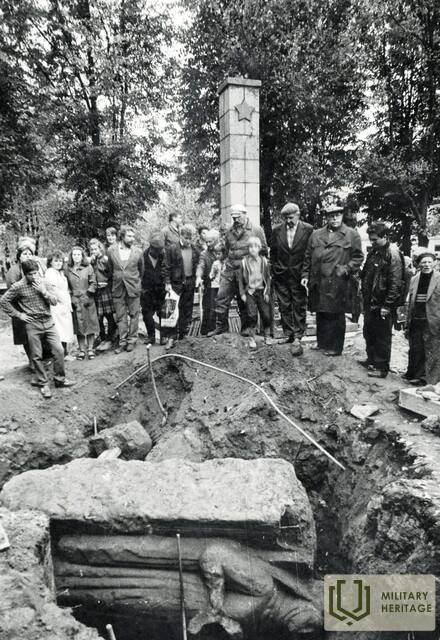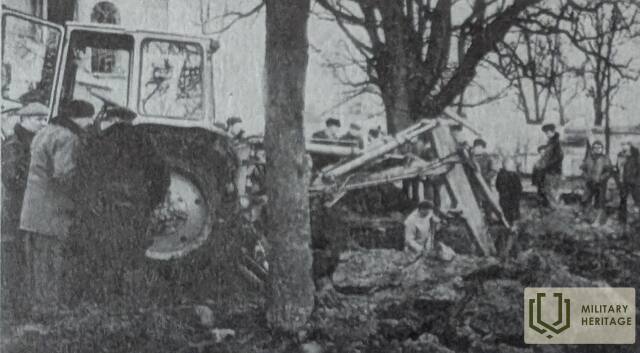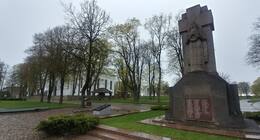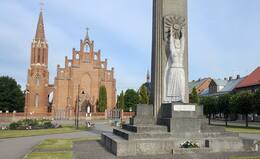Monuments to Lithuanian Independence. Histories of Monuments Created by Roberts Antinis: (III) Revival

One of the manifestations of the changing society during the Lithuanian Persistörkymo Sąjūdis era was the search and restoration of Independence monuments destroyed during the Soviet era, which began in 1988. Symbols of Independence, Freedom and Statehood once again appeared in Lithuanian cities and towns.
In 1987, the first public organizations independent of government institutions began to be established in Lithuania. Their field of activity was the Soviet bloc and the sore spots of society - environmental and heritage protection problems. Soon, organizations began to appear that posed even more serious challenges to the Soviet regime. In 1988, the Lithuanian Movement for Reorganization was established (the Sąjūdis initiative group was established on June 3, and the founding congress of Sąjūdis took place on October 22–23). The activities of these movements led Lithuania to the restoration of statehood on March 11, 1990.
With the birth of the Sąjūdis, society began to speak more and more boldly about the former Lithuanian Freedom and Statehood, and historical narratives and memories that had been suppressed by the Soviets began to awaken. People's gazes also turned to the monuments of Lithuanian Independence that had been destroyed during the Soviet era. This was another sign of society's awakening. We will share several stories, following the fates of the monuments of Independence created by sculptor Roberts Antinis (senior) (link to part one and part two ).
Širvintos. The monument that stood in Širvintos town square was demolished by local Soviet activists in the 1950s. Three decades passed and a challenge was thrown to this Soviet censorship of memory and landscape. In the summer of 1988, on the initiative of the Širvintos residents, a search began for the remains of the destroyed monument. In early 1989, its pedestal was excavated, and one of its details, the hand of the sculpture, was found. It became obvious that the old monument from the interwar years had been lost. It was decided to create and erect a copy of it. The monument was restored in 1991. Its sculptural part (a copy of the old sculpture) was created by the son of the sculptor Robertas Antinis (senior), who had already left for Lithuania, also a sculptor, Robertas Antinis (junior).
Biržai. The monument was destroyed at the beginning of the second Soviet occupation, in the spring of 1946. In the autumn of 1988, at the request and with the participation of the people of Biržai, the remains of the destroyed monument were excavated. It was decided that the ruins of the monument would no longer be restored. A copy of it was created. Once erected, it was no longer in its original place, but next to it. The former monument was occupied by the cemetery and memorial of the occupying Soviet troops. The monument was restored in 1990. The copy of the monument was created by Robertas Antinis (junior) based on the surviving remains.
Rokiškis. The Independence Monument, built in the central square of the city, was not demolished and stood throughout the Soviet era. It only needed to be restored. In 1989, the monument was restored by Robertas Antinis (the younger). Its elements plastered over during the Soviet era were revealed - the inscription "1918–1928" testifying to the intention of the monument and the swastika symbol.
Kretinga. Robertas Antinis (senior) was also considered the author of the Independence Monument in Kretinga. The monument was toppled in 1948. In 1989, while cleaning the Akmena Riverbed, the stone obelisk of the monument was found. The obelisk was found broken, without the bronze details that decorated it. It was decided that due to its very poor condition, restoration of the authentic element was no longer possible. Therefore, a copy of it was created and built. The monument was unveiled on February 16, 1990. Three dates are recorded on the pedestal of the rebuilt monument - the construction of the monument, its destruction and reconstruction. The decorations of the monument were restored by Robertas Antinis (junior). He also questioned whether the Independence Monument in Kretinga was his father's project: the style is uncharacteristic, and no drawings of the monument were found in the sculptor's personal archive. The author of this monument is now considered to be Jonas Akinskas, a stonemason from Kretinga.
During the interwar years, all of these monuments were built on the initiative and efforts of local people. It is telling and symbolic that their revival in 1988–1991 also took place through the will of local people. Unfortunately, destroyed monuments often had to be rebuilt, copies built, but the relics of old monuments should not be forgotten: in Biržai and Širvintos, the surviving authentic parts of the monuments are exhibited next to the newly built monuments, and the obelisk of the Kretinga monument is kept in the local museum.
- Juozas Banionis, “Biržai, Vytautas St. Monument to Those Who Died for Lithuanian Freedom”, in: Monuments of the Victims, Vilnius: Science and Encyclopedia Publishing House, 1994, pp. 19–20.
- "Biržai - a monument to those who died for the Independence of Lithuania", in: Panevėžys County Gabrielė Petkevičaitė-Bitė Public Library, 2020-03-18, available online: https://paneveziokrastas.pavb.lt/virtuali-fotoparoda/lietuvos-valstybingumo-zenklai-panevezio-apskrityje-paminklai-laisvei-ir-nepriklausomybes-kovu-kariams-savanoriams-2/birzai-paminklas-zuvusiems-uz-lietuvos-nepriklausomybe/ .
- Julius Kanarskas, “Kretinga, Town Hall Square. Freedom Monument”, in: Victims of Monuments, Vilnius: Science and Encyclopedia Publishing House, 1994, p. 87.
- Jolanta Klietkutė, “Monument to the Decade of Lithuanian Independence (1928–1928) in Kretinga (Freedom Monument)”, in: Kretingos krašto enciklopedija, 2014 (updated 2020-01-11), available online: https://www.kretingosenciklopedija.lt/kultura/kulturos-paveldas/istorinis-paveldas/paminklai/paminklas-lietuvos-nepriklausomybes-desimtmeciui-1928-1928-pamineti-kretingoje-laisves-paminklas/ .
- Girdas Paliulis, Eugenijus Žitlinskas, "Širvintos, Vilniaus g. Lithuanian soldiers' monument", in: Victims' monuments, Vilnius: Mokslo ir encyclopaedidės publishing house, 1994, p. 175.
- Aldona Pivoriūnienė, “Rokiškis, the Century of Independence. Monument of the Decade of Independence”, in: Victims of Monuments, Vilnius: Science and Encyclopedia Publishing House, 1994, p. 153.
- "Rokiškis - Monument to the Decade of Lithuanian Independence", in: Panevėžys County Gabrielė Petkevičaitė-Bitė Public Library, 2020-04-16, available online: https://paneveziokrastas.pavb.lt/virtuali-fotoparoda/lietuvos-valstybingumo-zenklai-panevezio-apskrityje-paminklai-laisvei-ir-nepriklausomybes-kovu-kariams-savanoriams-2/rokiskis-lietuvos-nepriklausomybes-desimtmecio-paminklas/ .
Related timeline
Related objects
Independence Square in Biržai
In the center of Biržai city.
A place of remembrance of the battles for freedom and a witness to the memory wars.
In 1931, on the former square next to the Church of St. John the Baptist, a monument to those who died for the Independence of Lithuania was erected at the initiative of the local team of the Lithuanian Riflemen's Union. The square became known as Independence Square, and the people of Biržai called the monument itself "Birute" (in honor of the Grand Duchess of Lithuania). The square became a place for various celebrations and commemorations. Flowers were laid at the monument, and riflemen or scouts' oaths were taken. After the Soviets occupied Lithuania, the monument did not last long - in 1946 it was blown up and buried where it stood. A cemetery for Soviet soldiers was established on the site of the Independence Monument.
In 1988, the people of Biržai excavated the remains of the destroyed monument. And in 1990, an exact copy of this monument was restored, only it was no longer erected in its original place, but further away, next to the cemetery of Soviet soldiers. In 2006–2007, the monument was restored, and a plaque with the names of 60 Lithuanian volunteers, soldiers, partisans and riflemen who died was attached to its pedestal. In 2017, another memorial plaque was unveiled next to the monument - to the knights and volunteers of the Vytis Cross of the Biržai parish in the 1919–1920 Independence battles.
In 2011, original fragments of the original monument were brought and exhibited next to the church.
In 2005–2010, the square was reconstructed. It is believed that in the 16th–17th centuries, this place was supposed to be an empty field between the castle's defensive moat and the townspeople's plots. Later, the area was divided into plots. When reconstructing the square, it was intended to reflect these stories: narrow, diagonal marks resembling cannonball trajectories semantically connect the square with the castle, and the wider lanes crossing the square more or less correspond to the boundaries of the townspeople's plots that were here in later times.
In 2021, the square was officially renamed Independence Square. The square remains the burial place of Soviet soldiers from World War II, marked by an obelisk and memorial plaques. It is believed that soldiers and spies from the NKVD-MVD-MGB units who died in battles with partisans in the Biržai region in 1945–1954 were also buried here.
Independence Square in Rokiškis
In the center of Rokiškis city.
The highlight of Independence Square is the monument erected in 1929–1931 to commemorate the 10th anniversary of Independence. The monument depicts a Lithuanian soldier and a Lithuanian woman holding a sun with a swastika depicted on a shield in her raised hands. This is one of those rare cases when a monument erected in Independent Lithuania during the Soviet era was not destroyed. Only in 1970 was the inscription “1918–1928” and the swastika plastered over. In 1989, the monument was restored.
Since the monument was erected in 1931, the square has been known as Independence Square.
A memorial plaque with the inscription “In this square, in the post-war years (1944–1953), the bodies of the fighters killed for the freedom of Lithuania were desecrated” commemorates one of the most painful stages in the history of this square. At least three buildings surrounding the square housed Soviet repressive structures that imprisoned, interrogated and tortured Lithuanian people in 1944–1953 (Nepriklausimobės a. 5, 10, 15). These buildings are marked with commemorative plaques.








